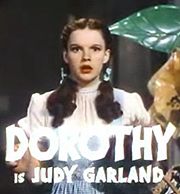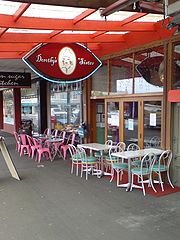
Friend of Dorothy
Encyclopedia

Gay slang
LGBT slang, LGBT speak or gay slang is a set of slang used predominantly among lesbian, gay, bisexual and transgender people. It has been used in various languages, including English and Japanese since the early 1900s as a means by members of the LGBT community as a group to self-advertise as a...
, a "friend of Dorothy" (occasionally abbreviated FOD) is a term for a gay
Gay
Gay is a word that refers to a homosexual person, especially a homosexual male. For homosexual women the specific term is "lesbian"....
man. The phrase dates back to at least World War II
World War II
World War II, or the Second World War , was a global conflict lasting from 1939 to 1945, involving most of the world's nations—including all of the great powers—eventually forming two opposing military alliances: the Allies and the Axis...
, when homosexual acts were illegal in the United States
United States
The United States of America is a federal constitutional republic comprising fifty states and a federal district...
. Stating that, or asking if, someone was a "friend of Dorothy" was a euphemism
Euphemism
A euphemism is the substitution of a mild, inoffensive, relatively uncontroversial phrase for another more frank expression that might offend or otherwise suggest something unpleasant to the audience...
used for discussing sexual orientation
Sexual orientation
Sexual orientation describes a pattern of emotional, romantic, or sexual attractions to the opposite sex, the same sex, both, or neither, and the genders that accompany them. By the convention of organized researchers, these attractions are subsumed under heterosexuality, homosexuality,...
without others knowing its meaning. A similar term "friend of Mrs. King" (i.e. Queen) was used in England, mostly in the first half of the 20th century.
Origins
The precise origin of the term is unknown and there are various theories. Most commonly, it is stated that "friend of Dorothy" refers to the film The Wizard of OzThe Wizard of Oz (1939 film)
The Wizard of Oz is a 1939 American musical fantasy film produced by Metro-Goldwyn-Mayer. It was directed primarily by Victor Fleming. Noel Langley, Florence Ryerson and Edgar Allan Woolf received credit for the screenplay, but there were uncredited contributions by others. The lyrics for the songs...
because Judy Garland
Judy Garland
Judy Garland was an American actress and singer. Through a career that spanned 45 of her 47 years and for her renowned contralto voice, she attained international stardom as an actress in musical and dramatic roles, as a recording artist and on the concert stage...
, who starred as the main character Dorothy, is a gay icon
Gay icon
A gay icon is a public figure who is embraced by many within :lesbian, :gay, :bisexual and :transgender communities...
. In the film, Dorothy is accepting of those who are different. For example the "gentle lion" living a lie, "I'm afraid there's no denyin', I'm just a dandy
Dandy
A dandy is a man who places particular importance upon physical appearance, refined language, and leisurely hobbies, pursued with the appearance of nonchalance in a cult of Self...
lion." Others claim that the phrase refers to celebrated humorist and critic Dorothy Parker
Dorothy Parker
Dorothy Parker was an American poet, short story writer, critic and satirist, best known for her wit, wisecracks, and eye for 20th century urban foibles....
, who included some gay men in her famous social circle.
Misunderstanding
In the early 1980s, the Naval Investigative Service was investigating homosexuality in the ChicagoChicago
Chicago is the largest city in the US state of Illinois. With nearly 2.7 million residents, it is the most populous city in the Midwestern United States and the third most populous in the US, after New York City and Los Angeles...
area. Agents discovered that gay men sometimes referred to themselves as "friends of Dorothy." Unaware of the historical meaning of the term, the NIS believed that a woman named Dorothy was at the center of a massive ring of homosexual military personnel. The NIS launched an enormous hunt for Dorothy, hoping to find her and convince her to reveal the names of gay servicemembers.
Current usage

Cruise line
A cruise line is a company that operates cruise ships. Cruise lines have a dual character; they are partly in the transportation business, and partly in the leisure entertainment business, a duality that carries down into the ships themselves, which have both a crew headed by the ship's captain,...
s, gay passengers began approaching ship staff, asking them to publicise gatherings in the daily cruise activity list. As the cruise lines were hesitant to announce such things so blatantly in their daily publications, they would list the gathering as a "Meeting of the Friends of Dorothy". Such meetings have expanded in popularity and frequency over the years. Now, many cruise lines will have multiple "FOD" events, sometimes as many as one each night.
Further reading
- Chauncey, George (1994). Gay New York: Gender, Urban Culture, and the Makings of the Gay Male World, 1890-1940. New York: Basic Books.
- Duberman, Martin (1993). Stonewall. New York: Dutton. Lesbian and gay life before and after Stonewall, as seen by six contemporaries.
- Duberman, Martin, Martha VicinusMartha VicinusMartha Vicinus is an American scholar of English literature and Women's Studies. She serves as the Eliza M. Mosher Distinguished University Professor of English, Women's Studies, and History at the University of Michigan, Ann Arbor. She has written several books about Victorian Women as well as...
, and George Chauncey, Jr. (eds) (1989). Hidden From History: Reclaiming the Gay and Lesbian Past. New York: NAL Books. Twenty-nine essays covering aspects of the gay and lesbian world from ancient to contemporary times. - Grahn, Judy (1990). Another Mother Tongue: Gay Words, Gay Worlds. Boston: Beacon Press. Explores the use of language to define gay and lesbian culture by examining stereotypes as access points into history.
- Katz, Jonathan (1992). Gay American History: Lesbians and Gay Men in the U.S.A.: a Documentary History. Rev. Ed. New York: Meridian.
- Marcus, Eric (1992). Making History: The Struggle for Gay and Lesbian Equal Rights, 1945-1990: An Oral History. New York: HarperCollins.

